-
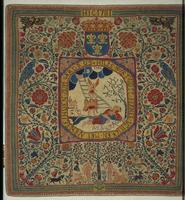 Carpet
Carpet This is a hand knit carpet indicative of the requirements journey men had to make in order to become part of any Hand-Knitter's Guilds around Europe. Knitting Guilds developed as early as the 14th century. It is believed to have taken three years of trained to become a journeyman. To gain membership into the guild, journeymen knitters had two produce what are called masterworks. This example from the 18th century probably meets one of the requirements: a wall hanging patterned with flowers. This artisan from Strasbourg went above and beyond with the carpet featuring the figures of Adam and Eve, Jacob's Dream and the inscription "Hilfe wirt gott ferner schicken meinne feinden zum verdus" : God will continue to send help in despite of mine enemies.
-
 Petticoat
Petticoat Mysterious knitted garment due to its intricacy and lack of seeming but size made it unusual for this time and hand knit nature. Knit with 2-ply wool, this petticoat has surface decoration of animals, birds, and trees knitted in purl and plain stitch. There are no seams meaning the piece was knitted in the round (not possible on a frame at the time) with a circumference of over 3 meters. The pattern does not repeat. A true mystery of knitting this is probably the work of a master knitter, possibly for entry into a guild, knit on fine needles with 2-ply wool.
-
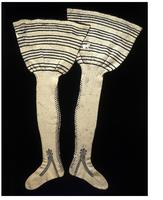 Pair of hose
Pair of hose The stocking stitch got it from items like this. The tops of these hose were designed to fit inside the Cavalier boots popular during the reign of Charles I (reigned 1625-1649). The wide boots were worn with tops turned down. The shape of these hose imitate those of the cloth hose also fashionable during this time even those woolen hose became more popular. The 2-ply wool hose are knitted in stocking stitch, top down, in the round with the knitter casting on 375 stitches which were reduced as the knitter worked down the sock. At 140 stitches the knitter kept this number down the leg of the hose. The heel uses a “Dutch” heel (turned heel) until the piece was cast off at the toes.
-
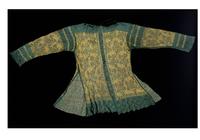 Jacket
Jacket This loose fitting jacket was constructed from separated panels of knitting joined together including the sleeves. The floral patterns in stocking stitch and purl were influenced by contemporary woven tapestry designs. Like the previous example, the combination of knit and purl stitches create a very interesting hem of the basket weave stitch. The combination of faded coral colored and gold silks was common in England with a paper of 1712 reporting the theft of “a green silk knit waistcoat with gold and silver flowers all over it.” (Victoria and Albert Museum)
-
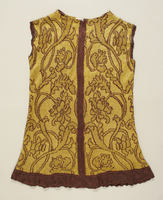 Jacket
Jacket One of the earliest examples of knitted clothing, this silk jacket shows extreme craftsmanship within the variance of stitch. The artisan moved between stocking, purl, and lace techniques to create a variety of effects throughout the piece including the chevron design along the bottom hem. The two pieces were knit flat and then seamed together as indicated by the brown stitching along the sides. This was type of construction was typical of period where most pieces were made in Italy (the center of production) and then assembled by the buyer at the final destination.
-
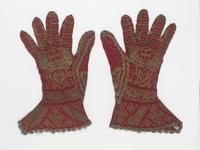 Pair of gloves
Pair of gloves A pair of red silk ecclesiastical gloves from Spain, marking some of the earliest examples of knitting on the European continent. These gloves also show how intricate color work had become. Knit in the round, the maker used yellow silk wrapped in silver strip to create many religious symbols on the glove like a cross surmounting a heart, a shepherds crook and reliquary. The cuffs have a geometric pattern and Greek wave which is repeated on the fingers. Yellow bobbin lace gives the appearance of seam lines.
-
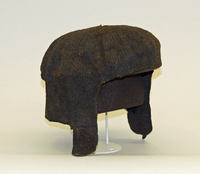 Flat cap
Flat cap Similar to other caps from this time, this cap of green wool highlights the protective nature of these caps with ear flaps and a longer neck. Construction suggests that this cap was worked flat joining in the round for the top and the ear flaps were constructed separately and seamed at the end. During this time, knitted caps were usually felted heavily in order to imitate velvet.
-
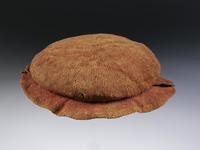 Cap
Cap This reddish-brown closely knitted cap with flat crown, has lost original felt surface and presumably bright red color. The cap has a slightly projecting brim of reverse stocking stitch construction. there are the remains of strings attached at each side suggesting that the cap was meant to be tied at the crown. Size suggests it may have belonged to young boy/small adult male however its was popular during the time for men to wear these caps on the side of the head, rather than on top. The manufacture of caps during this time was mandated from 1488 on control by Act of Parliament. In 1571, the “Cappers Act” stated that every person above the age of six years (excluding women and noblemen) shall wear a “on Sundays and Holidays a cap of wool, thickens and dressed in England” in order to keep the domestic production alive. This attributes the owner as securely in the middle class.
-
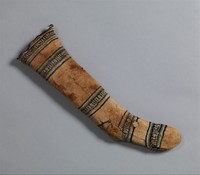 Sock
Sock Earliest example of double-needle knitting. Made in North Africa during Islamic rule as assumed from the indigo and white designs that echo color combinations found in most islamic ceramics of the time. The sock was most likely worked from toe to top with difference in needle size accounting for the change in gauge.
-
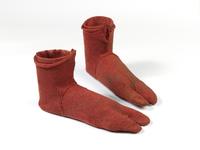 Pair of socks
Pair of socks The Romano-Egyptian socks were excavated from ancient Oxyrhynchus, a Greek colony on the Nile in central Egypt at the end of the 19th century. They use a technique called nålbinding which predates modern knitting. The socks were made with red wool and each sock has a divided big toe so as to be worn with sandals. The construction of these socks, which have a turned heel, began at the toe and finished at the ankle with added stitches in the front to form an under-flap, ending in a loop, for fastening or tying.
 Carpet This is a hand knit carpet indicative of the requirements journey men had to make in order to become part of any Hand-Knitter's Guilds around Europe. Knitting Guilds developed as early as the 14th century. It is believed to have taken three years of trained to become a journeyman. To gain membership into the guild, journeymen knitters had two produce what are called masterworks. This example from the 18th century probably meets one of the requirements: a wall hanging patterned with flowers. This artisan from Strasbourg went above and beyond with the carpet featuring the figures of Adam and Eve, Jacob's Dream and the inscription "Hilfe wirt gott ferner schicken meinne feinden zum verdus" : God will continue to send help in despite of mine enemies.
Carpet This is a hand knit carpet indicative of the requirements journey men had to make in order to become part of any Hand-Knitter's Guilds around Europe. Knitting Guilds developed as early as the 14th century. It is believed to have taken three years of trained to become a journeyman. To gain membership into the guild, journeymen knitters had two produce what are called masterworks. This example from the 18th century probably meets one of the requirements: a wall hanging patterned with flowers. This artisan from Strasbourg went above and beyond with the carpet featuring the figures of Adam and Eve, Jacob's Dream and the inscription "Hilfe wirt gott ferner schicken meinne feinden zum verdus" : God will continue to send help in despite of mine enemies. Petticoat Mysterious knitted garment due to its intricacy and lack of seeming but size made it unusual for this time and hand knit nature. Knit with 2-ply wool, this petticoat has surface decoration of animals, birds, and trees knitted in purl and plain stitch. There are no seams meaning the piece was knitted in the round (not possible on a frame at the time) with a circumference of over 3 meters. The pattern does not repeat. A true mystery of knitting this is probably the work of a master knitter, possibly for entry into a guild, knit on fine needles with 2-ply wool.
Petticoat Mysterious knitted garment due to its intricacy and lack of seeming but size made it unusual for this time and hand knit nature. Knit with 2-ply wool, this petticoat has surface decoration of animals, birds, and trees knitted in purl and plain stitch. There are no seams meaning the piece was knitted in the round (not possible on a frame at the time) with a circumference of over 3 meters. The pattern does not repeat. A true mystery of knitting this is probably the work of a master knitter, possibly for entry into a guild, knit on fine needles with 2-ply wool. Pair of hose The stocking stitch got it from items like this. The tops of these hose were designed to fit inside the Cavalier boots popular during the reign of Charles I (reigned 1625-1649). The wide boots were worn with tops turned down. The shape of these hose imitate those of the cloth hose also fashionable during this time even those woolen hose became more popular. The 2-ply wool hose are knitted in stocking stitch, top down, in the round with the knitter casting on 375 stitches which were reduced as the knitter worked down the sock. At 140 stitches the knitter kept this number down the leg of the hose. The heel uses a “Dutch” heel (turned heel) until the piece was cast off at the toes.
Pair of hose The stocking stitch got it from items like this. The tops of these hose were designed to fit inside the Cavalier boots popular during the reign of Charles I (reigned 1625-1649). The wide boots were worn with tops turned down. The shape of these hose imitate those of the cloth hose also fashionable during this time even those woolen hose became more popular. The 2-ply wool hose are knitted in stocking stitch, top down, in the round with the knitter casting on 375 stitches which were reduced as the knitter worked down the sock. At 140 stitches the knitter kept this number down the leg of the hose. The heel uses a “Dutch” heel (turned heel) until the piece was cast off at the toes. Jacket This loose fitting jacket was constructed from separated panels of knitting joined together including the sleeves. The floral patterns in stocking stitch and purl were influenced by contemporary woven tapestry designs. Like the previous example, the combination of knit and purl stitches create a very interesting hem of the basket weave stitch. The combination of faded coral colored and gold silks was common in England with a paper of 1712 reporting the theft of “a green silk knit waistcoat with gold and silver flowers all over it.” (Victoria and Albert Museum)
Jacket This loose fitting jacket was constructed from separated panels of knitting joined together including the sleeves. The floral patterns in stocking stitch and purl were influenced by contemporary woven tapestry designs. Like the previous example, the combination of knit and purl stitches create a very interesting hem of the basket weave stitch. The combination of faded coral colored and gold silks was common in England with a paper of 1712 reporting the theft of “a green silk knit waistcoat with gold and silver flowers all over it.” (Victoria and Albert Museum) Jacket One of the earliest examples of knitted clothing, this silk jacket shows extreme craftsmanship within the variance of stitch. The artisan moved between stocking, purl, and lace techniques to create a variety of effects throughout the piece including the chevron design along the bottom hem. The two pieces were knit flat and then seamed together as indicated by the brown stitching along the sides. This was type of construction was typical of period where most pieces were made in Italy (the center of production) and then assembled by the buyer at the final destination.
Jacket One of the earliest examples of knitted clothing, this silk jacket shows extreme craftsmanship within the variance of stitch. The artisan moved between stocking, purl, and lace techniques to create a variety of effects throughout the piece including the chevron design along the bottom hem. The two pieces were knit flat and then seamed together as indicated by the brown stitching along the sides. This was type of construction was typical of period where most pieces were made in Italy (the center of production) and then assembled by the buyer at the final destination. Pair of gloves A pair of red silk ecclesiastical gloves from Spain, marking some of the earliest examples of knitting on the European continent. These gloves also show how intricate color work had become. Knit in the round, the maker used yellow silk wrapped in silver strip to create many religious symbols on the glove like a cross surmounting a heart, a shepherds crook and reliquary. The cuffs have a geometric pattern and Greek wave which is repeated on the fingers. Yellow bobbin lace gives the appearance of seam lines.
Pair of gloves A pair of red silk ecclesiastical gloves from Spain, marking some of the earliest examples of knitting on the European continent. These gloves also show how intricate color work had become. Knit in the round, the maker used yellow silk wrapped in silver strip to create many religious symbols on the glove like a cross surmounting a heart, a shepherds crook and reliquary. The cuffs have a geometric pattern and Greek wave which is repeated on the fingers. Yellow bobbin lace gives the appearance of seam lines. Flat cap Similar to other caps from this time, this cap of green wool highlights the protective nature of these caps with ear flaps and a longer neck. Construction suggests that this cap was worked flat joining in the round for the top and the ear flaps were constructed separately and seamed at the end. During this time, knitted caps were usually felted heavily in order to imitate velvet.
Flat cap Similar to other caps from this time, this cap of green wool highlights the protective nature of these caps with ear flaps and a longer neck. Construction suggests that this cap was worked flat joining in the round for the top and the ear flaps were constructed separately and seamed at the end. During this time, knitted caps were usually felted heavily in order to imitate velvet. Cap This reddish-brown closely knitted cap with flat crown, has lost original felt surface and presumably bright red color. The cap has a slightly projecting brim of reverse stocking stitch construction. there are the remains of strings attached at each side suggesting that the cap was meant to be tied at the crown. Size suggests it may have belonged to young boy/small adult male however its was popular during the time for men to wear these caps on the side of the head, rather than on top. The manufacture of caps during this time was mandated from 1488 on control by Act of Parliament. In 1571, the “Cappers Act” stated that every person above the age of six years (excluding women and noblemen) shall wear a “on Sundays and Holidays a cap of wool, thickens and dressed in England” in order to keep the domestic production alive. This attributes the owner as securely in the middle class.
Cap This reddish-brown closely knitted cap with flat crown, has lost original felt surface and presumably bright red color. The cap has a slightly projecting brim of reverse stocking stitch construction. there are the remains of strings attached at each side suggesting that the cap was meant to be tied at the crown. Size suggests it may have belonged to young boy/small adult male however its was popular during the time for men to wear these caps on the side of the head, rather than on top. The manufacture of caps during this time was mandated from 1488 on control by Act of Parliament. In 1571, the “Cappers Act” stated that every person above the age of six years (excluding women and noblemen) shall wear a “on Sundays and Holidays a cap of wool, thickens and dressed in England” in order to keep the domestic production alive. This attributes the owner as securely in the middle class. Sock Earliest example of double-needle knitting. Made in North Africa during Islamic rule as assumed from the indigo and white designs that echo color combinations found in most islamic ceramics of the time. The sock was most likely worked from toe to top with difference in needle size accounting for the change in gauge.
Sock Earliest example of double-needle knitting. Made in North Africa during Islamic rule as assumed from the indigo and white designs that echo color combinations found in most islamic ceramics of the time. The sock was most likely worked from toe to top with difference in needle size accounting for the change in gauge. Pair of socks The Romano-Egyptian socks were excavated from ancient Oxyrhynchus, a Greek colony on the Nile in central Egypt at the end of the 19th century. They use a technique called nålbinding which predates modern knitting. The socks were made with red wool and each sock has a divided big toe so as to be worn with sandals. The construction of these socks, which have a turned heel, began at the toe and finished at the ankle with added stitches in the front to form an under-flap, ending in a loop, for fastening or tying.
Pair of socks The Romano-Egyptian socks were excavated from ancient Oxyrhynchus, a Greek colony on the Nile in central Egypt at the end of the 19th century. They use a technique called nålbinding which predates modern knitting. The socks were made with red wool and each sock has a divided big toe so as to be worn with sandals. The construction of these socks, which have a turned heel, began at the toe and finished at the ankle with added stitches in the front to form an under-flap, ending in a loop, for fastening or tying.